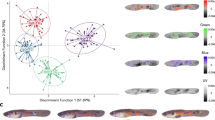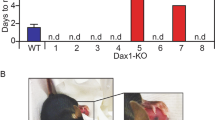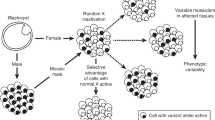Abstract
IN man the XYY chromosome complement has been reported by some authors to be associated with abnormal tallness, mental deficiency and sociopathic, aggressive behaviour1–4. The interpretation of this literature is controversial. Furthermore, any genetic variation(s) of the Y chromosome which affect(s) aggressive behaviour among chromosomally normal males could mask the correlation between a supernumerary Y and this behaviour5. If such variation exists, then in any population the correlation between the XYY karyotype and aggression would depend on the distribution of Y chromosomes having varying degrees of predisposition towards aggressive behaviour. Our investigations on the developmental genetics of fighting behaviour in mice support the hypothesis that there may be heritable variations of the Y chromosome which are associated to varying degrees with some types of aggression, and that this could account both for the lack of unusual aggressive behaviour in many individuals with an extra Y and for its occurrence in other XYY males.
This is a preview of subscription content, access via your institution
Access options
Subscribe to this journal
Receive 51 print issues and online access
$199.00 per year
only $3.90 per issue
Buy this article
- Purchase on Springer Link
- Instant access to full article PDF
Prices may be subject to local taxes which are calculated during checkout
Similar content being viewed by others
Change history
01 February 1975
In the article "Evidence for a Y chromosomal contribution to an aggressive phenotype in inbred mice" by M. K. Selmanoff, J. E. Jumonville, S. C. Maxson and B. E. Ginsburg (Nature, 253, 529; 1975) the column headings in Table 1 should read DBA/1 Fathers and C57BL/10 Fathers respectively, in both studies.
References
Court-Brown, W. M., J. med. Genet., 5, 341 (1968).
Hook, E. B., Science, 179, 139 (1973).
Kessler, S., and Moos, R. H., J. psychiat. Res., 7, 153 (1970).
Owen, D. R., Psych. Bull., 78, 209 (1972).
Jarvik, L. F., Klodin, V., and Matsuyama, S. S., Am. Psych., 28, 674 (1973).
Jumonville, J. E., thesis, Univ. Chicago (1968).
Scott, J. P., and Fredericson, E., J. Physiol. Zool., 24, 273 (1951).
Clark, L. H., and Schein, M. W., Anim. Behav., 14, 44 (1966).
van Abeelen, J. H. F., Genetica, 34, 79 (1963).
Bruell, J. H., in Behavior-Genetic Analysis (edit. by Hirsch, J.), 270 (McGraw-Hill, New York, 1967).
Eleftheriou, B. E., Bailey, D. W., and Denenberg, V. H., Physiol. Behav., 13, 773–777 (1974).
Ginsburg, B. E., Maxson, S. C., and Selmanoff, M., in Behaviour, Violence and Dependency (edit. by Genoves, S.), (Plenum, New York, in the press).
Southwick, C. H., Commun. behav. Biol., 1 A, 129 (1968).
Eichwald, E. J., and Silmser, C. R., Transplantation, 5, 148 (1955).
Polackova, M., and Vojtiskova, M., Folia biol., Praha, 19, 281 (1973).
Krzanovvska, H., Genet. Res., 13, 17 (1969): Proc. int. Sympt. Genet. Spermatozoon (edit. Beatty, R. A., and Gluecksohn-Waelsch, S.), 370 (Univ. Edinburgh, 1972).
Hayward, P., and Shire, J. G. M., Nature, 250, 499 (1974).
Dronamraju, K. R., Adv. Genet., 13, 227 (1965).
Winer, B. J., Statistical Principles in Experimental Design (McGraw-Hill, New York, 1962).
Author information
Authors and Affiliations
Rights and permissions
About this article
Cite this article
SELMANOFF, M., JUMONVILLE, J., MAXSON, S. et al. Evidence for a Y chromosomal contribution to an aggressive phenotype in inbred mice. Nature 253, 529–530 (1975). https://doi.org/10.1038/253529a0
Received:
Revised:
Issue Date:
DOI: https://doi.org/10.1038/253529a0
This article is cited by
-
Aggression in wild house mice: Current state of affairs
Behavior Genetics (1996)
-
Studies on wild house mice. v. aggression in lines selected for attack latency and their y-chromosomal congenics
Behavior Genetics (1994)
-
Genetic analysis of different kinds of aggressive behavior
Behavior Genetics (1993)
-
Y chromosome and aggression in strains of laboratory mice
Behavior Genetics (1990)
-
A developmental-genetic analysis of aggressive behavior in mice. II. Cross-sex inheritance
Behavior Genetics (1988)
Comments
By submitting a comment you agree to abide by our Terms and Community Guidelines. If you find something abusive or that does not comply with our terms or guidelines please flag it as inappropriate.



